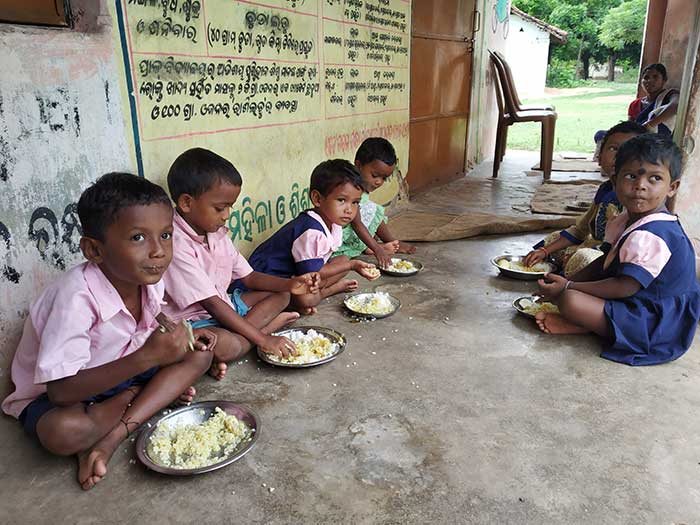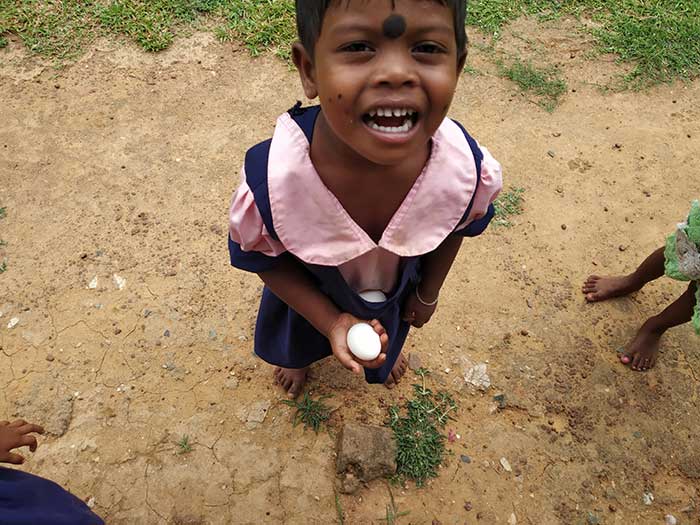It was barely a little after nine on a summer morning in Kandhei Posh village in Banei block, Sundergarh district of Odisha. The six children in the anganwadi centre (AWC) rush out after having spent two hours lazing indoors with some drawing, playing, and recitation in between. The fidgety young ones line up dutifully towards the pail of water outside to wash their hands while Tulasa, the anganwadi helper (AWH), monitors them from a distance. They get back to the verandah of the AWC, take their choicest positions, and wait happily with their plates laid in front. For them, that was one of the special days of the week: it was an egg-day in their anganwadi.

Children having their meals at the AWC in Kandhei posh, Odisha. Picture Credits – Sweta Dash
Tulasa serves them the hot cooked meals – rice and the much awaited egg curry. Eggs are served in the AWC mid-day meals regularly from Tuesday to Saturday. “Not even the sweet badam laddoo we serve for breakfast excites them as much,” she says and takes a seat in one corner to see everyone’s plates. “Some of them mash the yolk with rice while others save it for a last bite, but eventually there is no trace of the egg left. It’s almost as if it was just never there!” she exclaims.
Across the road from the Kandhei posh anganwadi, a few men rested in the shade of trees after ploughing in their open agricultural lands.
Agriculture has not proven to be a financially sustainable option for the village, as is the unfortunate case in most agricultural areas, in the last many years. Most families here depend on their mahul flower produce, the oil extraction, however, is a long tedious process which fetches only a meagre price in the market. Further, as Kandhei posh village is situated at on a rocky uphill terrain four kilometre from even the Kasada Gram Panchayat, access to the market is severely limited. Coupled together, these factors make the villagers all the more reliant on welfare schemes like the Supplementary Nutrition Programme (SNP) assuring hot cooked mid-day meals, and take-home rations to children and women.
Egging on for Health and Nutrition of Women

Tapaswini Naik carrying eggs for her mother. Photo Credits – Sweta Dash
When Tapaswini Naik, a four year old in that AWC, was dancing around with her friends and getting ready to leave, Tulasa called her back again. Tapaswini looked confused for a brief moment and then her eyes lit up. She sprints to the verandah and hugs Tulasa tight. That was her day to carry eggs back home to her mother. With one egg in her hand and another hidden in her tunic, she twirls around gleefully and says, “My mother will eat eggs and become stronger soon. And then, I and my baby brother will play with her all day!”
Tulasa explains that sometimes the women find it difficult to collect their THR and eggs from the AWC themselves, and in such cases the AWW or AWH hand it over to their trusted family members. “It’s better to give it to Tapaswini, I feel. No adult can ever carry the eggs with that much care for the women,” she adds.
During a 15-day survey across 12 villages in Odisha last month, it was observed that the necessity of eggs for pregnant and lactating mothers cannot be emphasized enough. Most pregnant women weighed less than 50kgs, suffered from low haemoglobin count and low blood pressure. Their diets were severely limited, more so with milk and fruits being inaccessible and/or unaffordable for most women. Anaemia remained a common ailment that has even resulted in medical complications during delivery.
The provision of eggs for pregnant and lactating mothers also goes a long way in addressing the persistent inequality of nutrition within the household. Kanika Sharma asserts, “Access and freedom to nutrition outside the household provided by government programmes are, by most measures, a concrete step towards gender equality.”
The case for sustained Government Interventions
In July 2018, the Odisha government revised the menu for the mid-day meals and take home ration (THR) provided in anganwadi centres for both children and women. The cost of SNP per head was enhanced to accommodate at least five eggs a week per child and twelve eggs per month for pregnant and lactating mothers. In fact, the take home ration was also revised to include dry ration like suji, besan, sugar, in addition to chhattua (chickpea flour) supplied on a monthly basis. An earlier revision in March, 2018 even goes further ahead to include millet based foods in the mid-day meals.
These revisions remains cognisant to the National Family Health Survey in 2015-16 (NFHS-4) data for Odisha which clearly illustrates the abysmal condition of food security and its repercussions on the health of women and children. 34% of children under the age of five are underweight, 20% are wasted (too thin for their height) and 34% are stunted. More than half (51%, to be precise) of women in Odisha are affected by mild to severe anaemia. The NFHS-4 also notes how these broader data units are fractured based on social positions and geographical locations. A crucial observation that notes this is how anaemia is particularly high for scheduled tribe women, Christian women, and women with no schooling.
The provision of eggs for women and children in the hot cooked meals and take home rations provided at anganwadis was set in place by the State government in 2011. Prior to that, soya chunks, pulses and vegetables formed a regular component of the food provided at anganwadis. With the beginning of a decentralised procurement, the State government also took into account the immense necessity of eggs in the diet. As Reetika Khera notes in a concise primer, eggs are indeed an excellent source of nutrition.
Standing tall against anti-egg resistances
The state government under the leadership of Pattnaik has been repeatedly criticised for doling out too many “freebie schemes”, as they often say in colloquial and rather elitist condescension but the state government has vehemently refused to give up. The continuous improvements in nutrition indicators in the NFHS-4 are a direct testament to the continuous systemic government interventions.
Sameet Panda, a Right to Food activist in Odisha comments that although there have surely been disparate opinion pieces about the opposition to the inclusion of eggs, there has been no such wider on-ground political discourse around the same. “For me, the anti-egg resistance in other states must be called out for what it is really – an anti-people resistance. That is a means to assert the hegemony of the upper caste and class population, while relegating others to the perils of food insecurity”, he notes and shares that he firmly believes there is no scope for such a phenomenon in Odisha anymore, irrespective of the fate of the political party in power.
The provision of eggs for women and children in Odisha should, perhaps, act as a timely reminder that there is surely no need for a regressive politicisation at the cost of their health and nutrition, as has been observed in the case of Chattisgarh and Karnataka recently. The right to food is far from realised anywhere in India, and with the central government trying to restrict welfare entitlements, rethinking social policies from below is more urgent than ever before.
Sweta Dash is pursuing Master’s in Gender Studies from Ambedkar University, Delhi, and is associated with the Right to Food campaign.
The writer is grateful to Jean Dreze and Reetika Khera for their comments and suggestions.
Right to Food campaigners from Odisha – Raj Kishor Mishra, Sameet Panda and Bidyut Mohanty have also been of incredible assistance.
Courtesy: Counter Current
